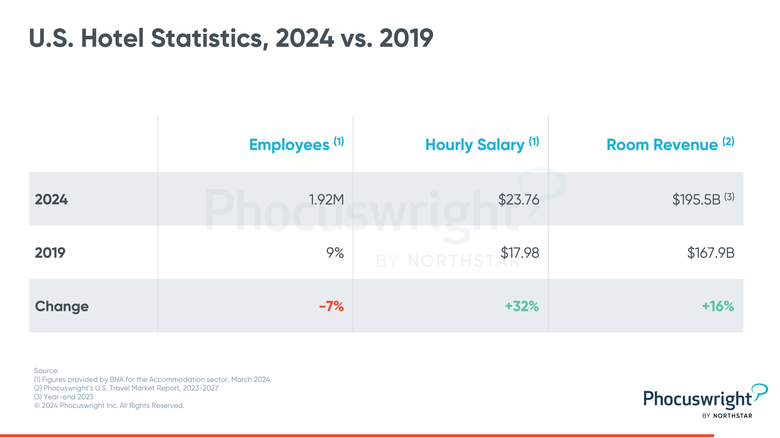-
The Travel Labor Shortage Should Be Over, So Why Are We Still Worried? – Image Credit Unsplash+
Phocuswright research has found that the hospitality industry is facing staffing challenges due to low pay, long hours, lack of remote work and declining interest.
The labor shortage in tourism and hospitality should be over by now, correct? Most hotels are back to full operation, airlines have enough pilots to fly their planes and people do and will need jobs. But the truth is, there is no simple fix.
While progress has been made in staffing since the troughs of the pandemic (see the July 2022 report Help Wanted: How Travel Survives the People Shortage), the talent crisis in travel still exists and could even get worse. Unlike the immediate effect from COVID, the impact will be felt more gradually.
Hospitality staffing in particular faces many challenges that aren’t going away.
A February 2024 AHLA survey of 400 hoteliers found that 67% are still experiencing staffing shortages, and 12% said the shortfall was “severe.” While not exclusive to hospitality, there has also been a decline in college enrollment in recent years – and among those who do aspire to a secondary education, fewer are choosing careers in hospitality. Reasons vary, but concerns about long hours, low pay and lack of remote work options have prompted many prospects to focus on other sectors.
For those who do take jobs in hospitality, many are left to navigate their careers on their own.
There are still not enough leaders or experienced veterans to mentor new hires. Following the pandemic, many of the most experienced executives have moved on to other hotel companies, formed consulting practices of their own, or retired. Without a strong pipeline of potential workers and ongoing training and upskilling, the talent pool for the travel industry is in jeopardy.
Not good enough
While it’s true that there have been great strides in staffing, there are still red flags. On a positive note, college enrollment is finally growing after four years of losses, and jobs are being filled. According to the U.S. Bureau of Labor Statistics (BLS), leisure and hospitality added 8 million jobs since the lowest point of the pandemic (April 2020-April 2024), with 16.9 million now employed. However, the unemployment rate for the travel industry still hovers at 6%, compared to the U.S. average of 4%.
The accommodation sector within leisure and hospitality had over one million job openings in May 2024, according to the BLS. Staffing has clearly not kept up with revenue growth, while labor costs continue to rise. Consider that in March 2024 there were 150,000 fewer employees in accommodation compared to March 2019 (pre-pandemic), a 7% decline versus a 16% increase in room revenue for a similar period. Even though technology is making hotels more efficient and much of the hotel market growth has been rate-related, there are still expectations of service, quality and innovation that can only be met with a dedicated and well-trained team in place.

Pipeline problem
With fewer young people entering college over the past several years, there is simply a smaller workforce in hospitality’s future. This will create a more competitive environment for the best talent – a challenge for hospitality and tourism. Considering the inflated cost of education, fewer parents are encouraging their children to pursue hospitality occupations for fear it might take years to pay off their college debt. Instead, careers in healthcare, technology or finance are often preferred.
On the bright side, there has been an uptick in students entering college since the falloff that occurred during the pandemic.
According to the National Student Clearinghouse Research Center, undergraduate enrollment grew 2.5% (+359,000) in spring 2024, marking the second consecutive semester of enrollment growth following several years of decline since spring 2020. Most gains were in community college growth as opposed to four-year degrees, indicating students are taking a more cautious or economical approach to education.
Still concerning is that undergraduate enrollment in 2024 remains about one million students short of 2019 totals.
Hotel schools feel the pinch
The shortfall in enrollment is not the only challenge afoot. There are serious gaps in hospitality programs across the country at the university level, including at some of the most prestigious hotel schools. This foretells a serious shortfall of leaders over the next 10 years. There is no dearth of hospitality programs and degrees, but where are the students?
What’s next?
While airlines work out their labor issues, hotels are still plagued with the reality that a weaker talent pipeline can threaten future operations. A recent survey of hotel professionals by SSP reported that 70% found the recruitment process difficult because workers want more flexibility and remote work options, while more than half said the pay scale was not high enough.
The staffing challenge in hospitality will always be an issue due to the lower pay scale compared to other professional tracks, but it doesn’t have to be a detriment to hotel operations.
To best prepare for the future, hotels need to follow the data and adopt strategies that attract the best prospects: Giving workers more flexibility, promoting opportunities from within, and raising the perception of hospitality as a career choice should help fill the talent pool in the coming years.
Get Phocuswright’s report, The Labor Shortage Should Be Over, So Why Are We Still Worried?, that dives deep into data on hospitality school educators, students and hospitality-related programs.


